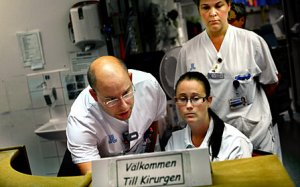This article on DN (major Swedish newspaper) caught my attention this morning:
The title of the article is "Waiting times at Huddinge halved with new process". Some highlights:
- The new way of working halves the waiting times for patients at the Surgical Intensive Care Unit.
- What’s happening now is a paradigm shift, a complete cultural change.
- The new way of working isn’t really that complicated – it is based on simple principles and common sense.
- We asked ourselves: when do we work well? When don’t things work well? What is important? We realized that we work best during alarms. Then everybody is in the room at the same time, there are no communication barriers, and everyone is pitching in together. This became the guiding principles of our new process.
- Hospitals are traditionally organized like a roman hierarchy. All clinics do their own part, nobody follows up what happens to a patient that is handed down to the next department. Patients don’t move from bottom to top, they move horizontally through the organization. Therefore we need to work that way as well.
- Vi implemented an advanced IT system that allows us to measure the time it takes for a patient from entry, to the doctor, to the (…. etc etc…) all the way until the patient is signed out. That way we can see what slows the process down and address this immediately. This gives us a quality metric.
- Next step is to give other units time to figure out for themselves how they could work best.
We spend a lot of time helping IT companies understand how to use Lean principles to increase the speed and quality of their product development. It’s interesting to see how the same techniques are applied in totally different domains – in this case the intensive care unit at a hospital. The article is littered with examples of direct application of lean techniques (highlighted in bold above), yet the word "Lean" isn’t mentioned anywhere in the article. I assume that is because most readers wouldn’t be familiar with the term.
In Lean we walk a lot about "cycle time". In a software company, "cycle time" is typically the time it takes from when a new feature is conceptualized until that feature is in production. In a hospital, a good measure of cycle time is the time it takes from when a patient walks in through the door until that patient has received the right treatment and left the hospital.
When you focus on reducing the total cycle time using techniques such as Value Stream Mapping and Cross-Functional Teams using Scrum the effects can be profound. I’ve seen IT companies get over 5 times faster without any adverse side effects (other than the short-term pain of having to reorganize). Lean is all about optimizing the whole.
How can this work so well? Is Lean a silver bullet?
No. It’s just that most organizations seem to be riddled with waste that has accumulated over many years. In the same way that any architecture will degrade into a horrible mess over time if you don’t continuously refactor the system as it grows. It seems that most companies don’t continuously refactor their organization. The Lean term for that is Kaizen, or continuous process improvement.
Another problem is that many organizations consistently sub-optimize, i.e. they measure and optimize the wrong things. Simple exercises such as Pass the Pennies illustrate quite clearly how optimizing to make each department faster can make the cycle time of the whole organization worse.
Lean provides a host of powerful principles and tools to attack waste and sub-optimization. So Lean may feel like a silver bullet to companies that are in bad shape, at least until the worst of the problems are fixed.
Much of lean feels like common sense once you see it in action. Which brings to mind the following quote (no idea who said it first):
Common Sense Isn’t.






Spot on! This reminds me a lot about Mythical Man Month. “There’s no silver bullet!”. And it also tried to learn from hospital environments, surgical teams in particular. But MMM failed to draw the right conclusions from those studies. Well, that’s how I see it.
I also often think that we in the IT business have more to learn from other fields of work than they have from ours. Granted, Agile was packaged very well in software development, but some of the practices are age old and I think we have a lot more to learn. I wrote a little something about that a while ago: A visit at a construction site (sorry, Swedish).
Another article on yet another hospital going lean in Stockholm:
http://www.dn.se/DNet/jsp/polopoly.jsp?d=1298&a=841718
Cool, thanks for pointing that out!
BTW here’s a cleaned up version of the link above:
http://www.dn.se/DNet/jsp/polopoly.jsp?d=1298&a=841718
I think lean principles provided them a perspective of looking at the problem, and the ability to review measurements – that they previously haven’t had. By taking a step back and being able to see this bigger picture, they have been able to sort the waste and realise efficiencies.
Regards,
David
http://www.jacksguides.com